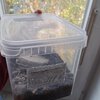- Joined
- May 7, 2004
- Messages
- 1,943
Not sure if this is a serious question, but the answer is "you don't." Drilling into glass just add cross ventilation is completely unnecessary.How do you add cross ventilation to a Glass tank , only my custom plexiglass lid I can drill in?

